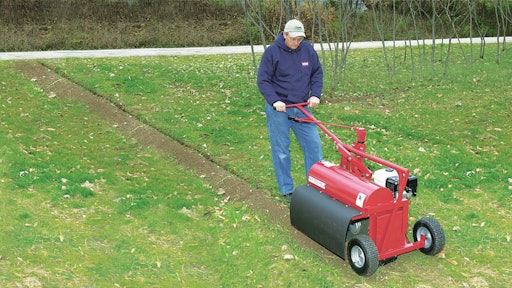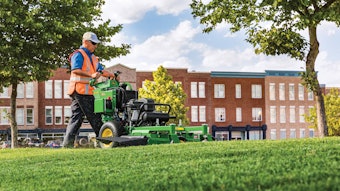
Today's trenchers can be summed up by a single word: variety. Trenchers can help landscape contractors accomplish a variety of tasks. There is also a variety of sizes and styles to choose from, including walk-behinds, ride-ons, and implements for your mower, skid steer or tractor.
The two main styles of walk-behind trencher are chain-type and wheel-type. "Unlike with chain trenchers, slit (wheel) trenchers cut very narrow trenches at a high rate of speed with a maximum depth of 12 inches," says Mike Hale, sales and marketing manager at Little Beaver Inc., manufacturer of the Kwik-Trench mini-trencher. "A chain-type trencher typically cuts to a 4- to 6-inch width at a low speed, and can trench up to 3 or 4 feet, depending on the manufacturer."
Hale offers some additional advice on what to look for in a standard walk-behind trencher, which could help you determine if a chain-type or wheel-type model would be better.
What are you going to use it for?
A landscape contractor must first ask himself what he plans on doing with his trencher. Common uses include irrigation system installation, low-voltage wiring for landscape lighting, edging and fencing.
Tree root pruning is yet another use for a walk-behind trencher. And according to Hale, it's growing in popularity. "If there's a root coming up next to a sidewalk or driveway, some contractors will use a trencher to cut the root down," Hale explains.
Trenching width and depth are important buying considerations. When trenching for landscape lighting, for instance, you may only need an inch-wide trench that's 6-8 inches deep. If you're looking to install an irrigation system, on the other hand, you might need to trench 8 inches deep in the South or 12 inches deep in the North.
Surface/soil type is another consideration. Your trencher must be able to handle the conditions you'll be working in. For example, the Kwik-Trench is designed to cut through tough surfaces such as compacted clay, road fill and asphalt. Rocky areas are off limits though, as the saw's high RPM could create a dangerous situation.
How easy is it to operate?
Because you'll possibly be using your trencher for a variety of tasks (as described above), investigate how easy it will be to adjust trenching depth. Having the ability to quickly adjust to a variety of trenching depths can prove to be a big plus. Same goes for trenching width. Examine how difficult it will be to change-out blades or cutting teeth in order to adjust trenching width.
Think about whether you want to push or pull. Some trenchers must be pulled because the blade spins clockwise.
Some trenchers are self-propelled, making operation easier. For those that are not, pay close attention to the tires. Pneumatic tires will make the trencher easier to maneuver.
Turning radius can be an important consideration if you'll be looking to do more than just trench in a straight line. This could be the case if you're looking to create a lot of landscape edges.
Post-job cleanup is something else to think about. Some trenchers are specially designed to deposit soil neatly beside the trench.
Will it stand up to tough use?
Depending on soil conditions, Hale says a good walk-behind trencher should be able to trench somewhere in the neighborhood of 10 to 30 feet per minute. Some brands claim to have models that can trench even faster than that. The depth of the trench certainly plays a role.
Speed is only one part of the productivity equation, though. Contractors also want a trencher that is built to withstand rigorous use, and is relatively easy to maintain and service.
"Kwik-Trench trenchers are all structural steel, hand-fabricated and welded," Hale cites as an example. A powder-coat finish also improves longevity by helping prevent rusting.
Find out if the trencher you're looking to purchase has any built-in features to protect it from damage when encountering an obstacle. For example, Hale says Kwik-Trench features a slip clutch disc system, which shuts the machine down if it hits underground rebar, for instance. This prevents the trenching wheel from incurring serious damage.
Ease of maintenance is also something to think about. Make sure the cutting teeth are easily replaceable. Hale says some brands feature teeth that are built right into the cutting wheel.
Safety and support
Finally, as is the case with all power equipment, find out about the various safety features the trencher offers.
Make sure you're buying from a quality servicing dealer who will be able to provide you with parts and service in a timely manner when needed.
And don't forget about rental as an option. If you only think you'll need a trencher a few times a year, renting can be the way to go. But if you think you'll get at least a couple full weeks' use out of it, Hale says purchasing likely makes the most sense.






























